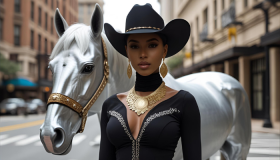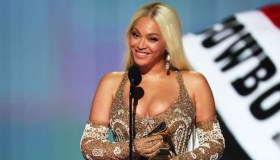Beyoncé's Albums By Psychological Feminine Archetypes
A Breakdown Of Beyoncé’s Albums By Psychological Feminine Archetypes
Share the post
Share this link via
Or copy link
Beyoncé wrapped her Cowboy Carter and The Rodeo Chitlin’ Circuit world tour in Las Vegas this past Saturday with a climactic, surprise, DC3 reunion, and the #Beyhive is already buzzing about what the Queen of pop, country, rap, opera, and R&B is going to do next. As we wait for the diva’s next act (ACT III), HelloBeautiful decided to fill the silence with a psychological review of Beyoncé’s eight-album discography on the three year anniversary of her afro-futurist-powered Renaissance debut. Beyoncé’s eight-solo studio albums, released across two decades (2003-2024), show not only the evolution of an artist, but the evolution of a woman.
Nina Simone once said, “An artist’s duty, as far as I’m concerned, is to reflect the times,” and if there is any modern artist who has used their discography to hand-walk culture through the evolution of feminine consciousness over the past two decades, it’s Beyoncé Giselle Knowles-Carter. From Dangerously In Love to Cowboy Carter, we listen to Beyoncé weave through every feminine archetype.
Beyoncé Albums By Archetype
Related Stories
Archetypes, according to famed Swiss psychologist Carl Jung, are described as universal models of behaviors and personalities that play a role in influencing human behavior. Jung’s theory of the collective unconscious states that these models or archetypes, like The Queen, The Maiden, and The Crone have accumulated in the unconscious mind of humanity since the dawn of civilization and are passed on through our ancestors. Although Jung, known as the father of modern psychology, is often credited with creating the concept of archetypes, the idea existed long before his 20th century seminal work, The Archetypes and the Collective Unconscious. Indigenous cultures like African, Native American, and South Asian folks have used archetypes to describe different aspects of the feminine psyche for generations, passed on through folklore and oral histories.
Love Black America Web? Get more! Join the Black America Web Newsletter
We care about your data. See our privacy policy.
The late Ayesha K. Faines, writer, Jungian researcher, and CEO of Women Love Power said, “There are seven feminine archetypes that prevail in contemporary western society, the mother, the maiden, the queen, the huntress, the sage, the mystic, and the lover. The presence of these archetypes in our psyches accounts for the major differences among women.”
For my exploration of Beyoncé’s albums from the lens of feminine archetypal evolution, I will pull from the work of Jung, Faines, and psychologists to pair each Beyoncé project with the archetypal essence it embodies. While Cowboy Carter, certainly isn’t Beyoncé’s final, cumulative work, the album does tell the story of a woman who has seemingly mastered, as Jung calls it, individuation, which is seen as a crowning moment in the psyche where two opposing sides of oneself (the shadow and conscious awareness) start seeing each other as partners, not opposites or enemies. At a time where America is holding the tension of its history on taut seams, Beyoncé’s Cowboy Carter Americana-themed work demonstrates not only the integration of her own complex musical dexterity, but also a mirror-reflection of a femme-future, where the psyche of the Black woman fully embodies her fullness, from the naïvety and innocence of The Maiden to the shrewd wisdom of The Crone.
Which Beyoncé album most represents your psyche right now? Scroll through and find out.
1. Dangerously In Love: The Maiden. June 20, 2003.

Dangerously In Love represents a maiden’s first voyage out on her own. When the album dropped, Destiny’s Child was still a group (their last album Destiny Fuffilled was released in 2004), but Beyoncé was bravely forging out on her own for the first time. Well, not fully alone. She had rapper Jay-Z alongside her right at the launch of her solo-career, which evolved into the iconic love story that built their billion-dollar hip-hop empire. The Maiden archetype represents the naïve virgin (which is no coincidence that Beyoncé’s zodiac sign, Virgo, is represented by The Virgin archetype, too). The Maiden is inexperienced and damsel-esque, but that innocence is where her power lies. She is not afraid to lean into her feminine charms of softness, nurturing, and loving, especially when she’s protected by her heroic knight (Jay).
2. B-Day: The Huntress/ Femme Fatale: September 4, 2006.

With B-Day, the artist got her solo footing with a high-powered, raucously self-loving second album. B-Day screams The Huntress archetype because she is unapologetically independent and free- spirited. She’s not afraid to demand a man to come hither, with lyrics like , “If you want to, you got the green light,” and she’s prone to leave if you’re not worshipping that kitty kat. In “Upgrade You” she sends listeners on a gender-role bender by embodying provider and protector energy, and on “Freak ‘Em” dress, we all get to dive into our femme-fatale energy through Beyoncé’s backless, dangerous, little Black dress. Beyoncé also expanded the bounds of her creativity with this album, releasing the project as a full-visual album. The Huntress is going to get what’s hers, and isn’t afraid to chase it down. Meow.
3. I Am…Sasha Fierce. November 12, 2008, The Trickster.

Beyoncé’s two-sided disc, I Am…Sasha Fierce was the unveiling of her alter ego’s voice and power, Sasha Fierce. Think of The Trickster like Gemini twins, or Jekyll and Hyde —two different masks of the same coin. While one face is socially acceptable and affable, the other is cunning, unpredictable, and ferocious. So while the I Am side included throaty, devotional ballads like “Halo,” and emotional longing (“Broken-Hearted Girl”), the Sasha Fierce side gives us big “Diva” energy and digital-era freak vibes in “Video Phone.” So which identity is she really? The trickster never tells.
4. June 24, 2011: The Mother

Beyoncé’s fourth album, 4, is a musical ode to a blossoming nurturer. She has learned to love herself, lose herself in love, and now, she’s ready to create love itself. Beyoncé announced she was expecting her first child just months after the album was released, with an MTV Awards performance of “Love On Top” on August 28, 2011 that revealed her growing baby bump. The album also includes tracks filled with themes of safety, security, and fertility. In the music video for “Best Thing I Never Had” she’s literally running around a green field in a wedding dress. And in “I Care,” we hear the passionate rock vocals of a woman not afraid to love deeply.
5. Beyoncé. December 13, 2013. The Mystic.

Beyoncé’s eponymous album was a surprise drop that tilted the entire music industry on its head. No one was expecting a full album from Bey, let alone a full artistically-loaded visual-album — but that’s the very embodiment of The Mystic: she seduces with mystery. The Mystic also represents freedom, and this album was Beyoncé’s first release through her own company, Parkwood Entertainment. This album represents a woman owning herself and the spirit of her work, fully. The songs and visuals are haunting, with airy, thug love meets heaven tracks like “No Angel,” or Partition’s Moulin-Rouge-coded peep show, the project is alluring, provocative, and dreamy.
6. Lemonade: The Hero, April 23, 2016.

Lemonade represents The Hero archetype because through the visuals and words we see a Black woman saving herself from betrayal using the power of alchemy (making lemonade from lemons). Beyoncé’s Lemonade era kicked off with her second Superbowl Half-Time performance ahead of the April album drop, where she released her new single, “Formation” on TV’s biggest stage. The track was a Black-woman powered militant call for freedom, by any means necessary. The Hero is the archetype women turn to when they need self-rescue and loving support from the wisdom of their foremothers and sisters. The archetype is a departure from the maiden-energy we see in Dangerously In Love, naïve, and somewhat dependent on a “Prince Charming” for safety. Instead, The Hero recognizes the warrior within herself – her own kick-ass and dependable soul-companion that isn’t afraid to cornrow her hair back, smash car windows with a bat, and throw wedding rings at cameras.
7. Renaissance: The Queen, July 29, 2022:

The Renaissance album is a triumphant body of work, fully embodying the bravado and power of The Queen. The Queen archetype represents self-sovereignty, and full, unapologetic ownership of one’s body, sexuality, and self-expression. It was perfect timing that the album dropped in the heat of summer’s Leo season, an astrological constellation marked by the lion, AKA, the King and Queen of The Jungle. Renaissance is about awakening the dormant big cat energy in everyone, with Beyoncé leading the way as royalty. The tracks declare, “I’m That Girl,” followed by body-loving anthems like “Cozy,” and “Thique,” and don’t forget the boastful luxury receipts of “Heated.”
8. Cowboy Carter: The Crone, March 29. 2024:

The Crone as an archetype embodies a lifetime of wisdom (and contains other archetypes like The Maiden and The Mother). According to holistic health practitioners, a woman embodies The Crone when she taps “into the psyche to reclaim primordial images and receive the power within them that honor older women.” Think Beyoncé leveraging Dolly Parton & Linda Martell on Cowboy Carter, as a musical homage linking the past to the present. Cowboy Carter also speaks to the double consciousness of being born both Black and American, and the rage of being the ancestral backbone of this country (through forced slave labor), while being legally and socially marginalized. In Cowboy Carter, we see those seemingly opposing identities integrate into a proud declaration of belonging: America is ours. That integration is what Jung calls, individuation, where two seemingly opposing sides find themselves on one accord, at last. Free at last.
A Breakdown Of Beyoncé’s Albums By Psychological Feminine Archetypes was originally published on hellobeautiful.com








